Kandy travel - Sri Lanka, Asia
Kandy, nestled in the Central Province of Sri Lanka, is a charming city set amidst rolling hills at an elevation of 500 meters (1,640 feet) above sea level, with the Mahaweli River flowing through it. Known for its tropical tea plantations, the city offers both cultural and natural beauty. With a diverse population, Kandy is home to primarily Sinhalese, alongside significant communities of Moors and Tamils.
Kandy’s cultural heritage is highlighted by its designation as a UNESCO World Heritage site and its vibrant annual Esala Perahera festival, known for its grand processions with decorated elephants. Surrounded by picturesque hills and tropical plantations, Kandy is also an educational hub, home to the prestigious University of Peradeniya and the renowned Peradeniya Botanical Gardens.
Population: Approximately 112,000 in 2024.
Economy: Tourism plays a vital role in Kandy's economy, attracting visitors for its rich cultural and historical significance. The city offers a wide range of accommodation to suit different budgets, from budget-friendly options like Feel Home to luxurious stays at Kings Pavilion and The Madulkelle Tea and Eco Lodge. Getting around Kandy is easy, with affordable tuk-tuks costing around 2,500 LKR for six hours, while taxis are also available at a higher rate.
Landmarks: Temple of the Sacred Tooth Relic (Sri Dalada Maligawa), Kandy Lake, Royal Botanical Gardens, Peradeniya, Udawattakele Forest Reserve, Bahirawakanda Vihara Buddha Statue, Ceylon Tea Museum, Lankatilaka Temple, Gadaladeniya Vihara, Kandy Viewpoint
Sri Lanka
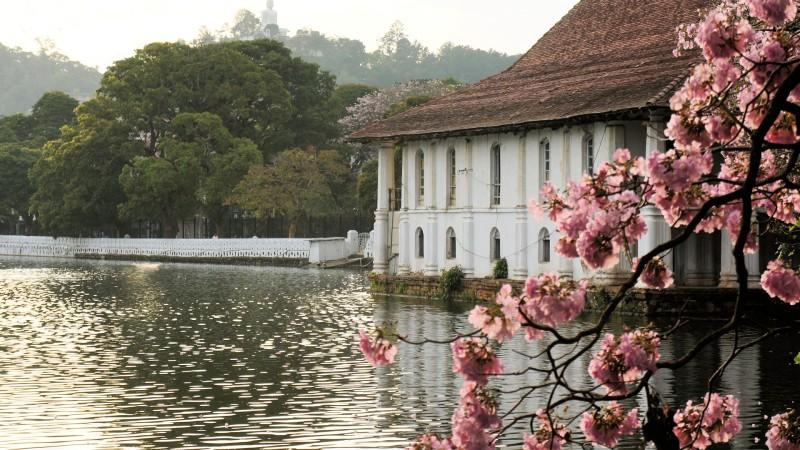
Overview of Kandy
History & Cultural Influence
Kandy, historically known as Senkadagalapura, holds a central place in Sri Lanka's history and culture, shaping its unique character. As the last capital of the ancient Sinhalese monarchy, Kandy maintained its independence from 1592 to 1815, resisting colonial powers like the Portuguese, Dutch, and British. This made it the final stronghold of Sri Lankan tradition and culture during centuries of foreign influence.
Religiously, Kandy became a significant Buddhist center, home to the revered Temple of the Tooth Relic (Sri Dalada Maligawa), which has been a symbol of royal and religious authority since the 4th century. This sacred relic has made the city a key pilgrimage destination for Buddhists worldwide, especially from the Theravada school.
The city's historical importance is also reflected in its architecture, with the royal palace and other structures showcasing Kandyan architecture. Designated a UNESCO World Heritage site in 1988, Kandy's legacy is preserved in its cultural festivals, like the grand Esala Perahera, a vibrant procession featuring dancers, drummers, and decorated elephants. Kandy’s resilience against colonial forces has fostered a strong sense of cultural pride, shaping its identity as a city that blends tradition with modern influences.
Interaction with The Locals
When visiting Kandy, you’ll find that the locals are warm, friendly, and eager to interact with tourists. The city’s diverse population is mostly Sinhalese, with notable communities of Sri Lankan Moors and Tamils. While Sinhala is the dominant language, Tamil is also widely spoken, and many people in the tourism sector speak English, making communication easy for visitors.
Kandy’s long history as a cultural and religious hub has fostered a welcoming atmosphere. Locals are often helpful and may show genuine curiosity about where you're from. It’s important to respect local customs, especially at religious sites—be sure to dress modestly and remove your shoes when entering temples. While the majority of interactions are positive, like any tourist destination, it's wise to be cautious about potential overcharging. Overall, the people of Kandy appreciate visitors and are proud to share their city’s rich history and culture.
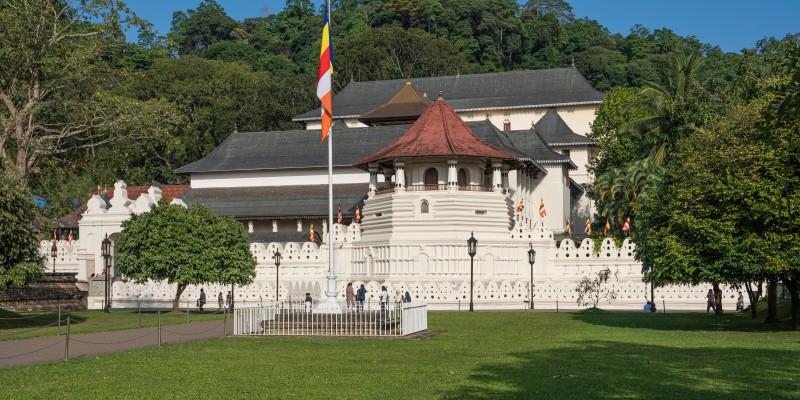
Temple of the Sacred Tooth Relic - © A.Savin
Top Attractions in Kandy
Kandy offers a rich blend of cultural and natural attractions that captivate visitors. The Temple of the Sacred Tooth Relic, a UNESCO World Heritage site, is a must-visit for its religious significance and stunning Kandyan architecture. Nature lovers will enjoy exploring the Royal Botanical Garden in Peradeniya, home to over 4,000 plant species, or taking a serene walk around Kandy Lake for beautiful city views.
Temple of the Sacred Tooth Relic (Sri Dalada Maligawa)
Location: Sri Dalada Veediya, Kandy
A UNESCO World Heritage site, the Temple of the Sacred Tooth Relic houses one of Buddhism’s most revered relics—Buddha's tooth. This sacred shrine holds immense significance in Sri Lanka’s Buddhist culture and draws thousands of pilgrims each year. The temple’s stunning Kandyan architecture is a highlight, with beautifully carved wooden doors and ivory inlays. Every year, it becomes the heart of the grand Esala Perahera festival, a procession featuring elephants, dancers, and drummers.
Royal Botanical Garden
Location: Peradeniya, 5.5km west of Kandy
Covering 147 acres, the Royal Botanical Garden is one of the largest and most beautiful in Sri Lanka. It boasts over 4,000 plant species, from spices to medicinal plants, and a world-renowned orchid collection. Walking through the garden, you'll find yourself surrounded by towering palm trees, exotic blooms, and a peaceful atmosphere, making it a perfect place for relaxation and nature lovers.
Kandy Lake
Location: City center, adjacent to the Temple of the Tooth
Built by the last king of Sri Lanka in 1807, Kandy Lake, also known as Kiri Muhuda (Sea of Milk), sits at the heart of the city. A picturesque 3.2 km walking path surrounds the lake, offering scenic views of both the temple and the city. It’s a popular spot for leisurely strolls and birdwatching, and its historical significance adds to the charm.
Udawattakele Forest Reserve
Location: Adjacent to the Temple of the Tooth
Once a royal garden for the Kandyan kings, Udawattakele Forest Reserve is now a protected 257-acre sanctuary. It’s home to a rich variety of plant species, birds, and small mammals. This serene forest is perfect for nature walks and meditation, with paths that lead to ancient monasteries tucked away within the lush greenery.
Bahirawakanda Vihara Buddha Statue
Location: Bahirawakanda hill, overlooking Kandy
Perched atop Bahirawakanda hill, this giant white Buddha statue overlooks Kandy with a serene presence. The site, which includes a monastery, offers panoramic views of the city below, and it’s especially striking when lit up at night. It’s a peaceful spot to take in the views and reflect on the spiritual essence of the city.
Embekka Devale
Location: Embekka, 12km southwest of Kandy
Famed for its exceptional wooden craftsmanship, Embekka Devale dates back to the 14th century and is dedicated to the Hindu god Kataragama. The temple is renowned for its intricate wood carvings, which are considered some of the finest examples of Kandyan artistry. This cultural treasure highlights the religious harmony and craftsmanship of the region.
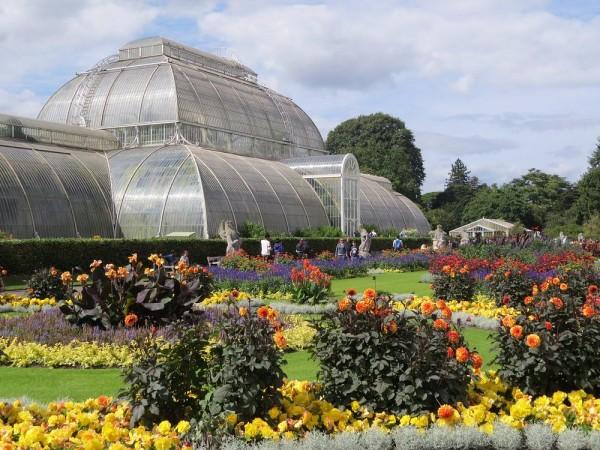
Royal Botanical Garden - © Wendy H
Must-Try Dishes in Kandy
When visiting Kandy, you can’t miss trying the iconic Kottu Roti, a delicious street food made from chopped flatbread stir-fried with vegetables, eggs, and meat. For a unique Sri Lankan experience, savor Lamprais, a Dutch-influenced rice dish wrapped in a banana leaf, or indulge in Hoppers, crispy bowl-shaped pancakes perfect for breakfast. Don't forget to treat yourself to Watalappan, a spiced coconut custard that’s a favorite dessert in the region.
Kottu Roti
Kottu Roti is a go-to street food in Kandy and across Sri Lanka, known for its bold flavors and satisfying mix of textures. It’s made by chopping up roti (flatbread) on a hot griddle and stir-frying it with vegetables, eggs, meat, and spices. The rhythmic sound of chopping is a signature feature, making the dish as much a sensory experience as it is a delicious one. Whether for dinner or a late-night snack, kottu roti never disappoints.
Lamprais
A treat from Sri Lanka's Dutch colonial past, lamprais is a meal packed with flavor. It's made by combining rice cooked in stock with a mix of curries, meatballs, shrimp paste, and plantains, all wrapped in a banana leaf and baked. Originating from the Burgher community, this dish is a true fusion of flavors and a must-try in Kandy if you're craving something hearty and unique.
Hoppers (Appa)
Hoppers are a staple breakfast item in Kandy, offering a light, crispy edge with a soft, spongy center. Made from rice flour and coconut milk, these bowl-shaped pancakes can be served plain, or with an egg cooked in the middle. Pair them with spicy sambol for a savory kick, and you’ve got a breakfast that’s both filling and packed with local flavor.
Kiribath (Milk Rice)
Kiribath, or milk rice, is a simple yet significant dish, often reserved for special occasions like the Sinhala and Tamil New Year. The rice is cooked with creamy coconut milk and then shaped into blocks, traditionally served with lunu miris, a spicy onion relish. It’s a comfort food deeply embedded in Sri Lankan culture and often symbolizes prosperity and new beginnings.
Watalappan
Watalappan is a rich and velvety coconut custard dessert with roots in Sri Lanka’s Malay community. Made with coconut milk, jaggery, and spices like cardamom and nutmeg, it’s a smooth and fragrant treat that’s particularly popular at celebrations. Think of it as Sri Lanka’s answer to crème caramel, but with a delicious tropical twist!

Kottu Roti - © gather
Weather in Kandy: Best Time to Visit
Average Temperatures
Kandy enjoys a tropical climate with warm temperatures throughout the year. The annual high averages around 29.4°C (84.9°F), while the lows hover around 20.4°C (68.7°F).
- January: High 27°C (81°F), Low 18°C (64°F)
- February: High 29°C (84°F), Low 18°C (64°F)
- March: High 30°C (86°F), Low 19°C (66°F)
- April: High 30°C (86°F), Low 21°C (70°F)
- May: High 29°C (84°F), Low 21°C (70°F)
- The warmest months are typically March and April, while December to January brings cooler, more pleasant weather.
Rainfall
Kandy receives an average of 228.7 mm (9.01 inches) of rain annually, spread over about 244 rainy days. The wettest months are during the monsoon seasons, from May to July and October to December. Peak rainfall generally occurs in April and October.
Humidity
Kandy's humidity levels stay high year-round, ranging between 70% and 80%, which can make the warmer months feel more intense.
Best Time to Travel
The ideal time to visit Kandy is between December and April, when the weather is drier and more comfortable.
- December to February offers cooler temperatures and lower humidity, making it perfect for sightseeing.
- March and April bring warmth and are ideal for witnessing cultural events like the Kandy Esala Perahera.
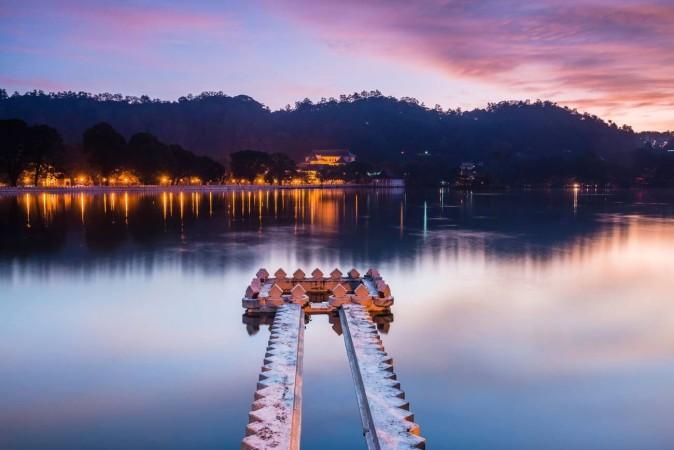
Kandy Lake - © gather
Festivals & Local Celebrations
Kandy Esala Perahera
Time: July/August (based on the lunar calendar)
Kandy's grandest festival, the Esala Perahera, is a spectacle that spans 10 days, culminating on the full moon night. During the festivities, you'll witness magnificent processions with beautifully adorned elephants, traditional Kandyan dancers, drummers, and awe-inspiring fire-dancers. The highlight of the event is the sacred tooth relic of Buddha, ceremoniously carried by the majestic Maligawa Tusker. The final day features a unique water-cutting ceremony, a tradition that draws thousands to the streets of Kandy.
Sinhala and Tamil New Year
Time: April 13-14
Kandy comes alive during the Sinhala and Tamil New Year, with a vibrant atmosphere full of traditional games, sports, and festive activities. Locals prepare special meals and sweets, while religious ceremonies are held in temples across the city. Visitors will experience a truly festive spirit with music, cultural performances, and an overall sense of celebration.
Vesak
Time: May (full moon day)
Vesak, commemorating the birth, enlightenment, and death of Buddha, is celebrated with great devotion in Kandy. The city is transformed with beautifully illuminated streets, temples adorned with lanterns, and symbolic acts of kindness like the release of captive birds. Don't miss the "dansal," where locals offer free food, or the striking pandols, large lit structures depicting scenes from Buddha’s life.
Kandy Day
Time: March 2nd
Kandy Day marks the 1815 Kandyan Convention, which brought an end to the Kandyan Kingdom. The city honors its rich history with special ceremonies at the Temple of the Tooth, cultural performances, and parades. Expect historical reenactments and exhibitions, alongside vibrant food fairs offering traditional Kandyan cuisine.
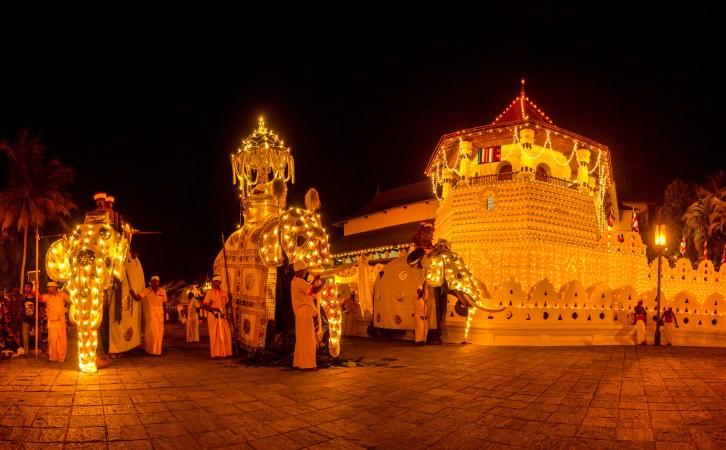
Kandy Esala Perahera - © Manilka Jayasingha
Culture Etiquette in Kandy
Dress Code
When visiting Kandy, especially religious sites, modest attire is essential. Ensure your shoulders and knees are covered, and always remove your shoes and hats before entering temples or homes as a sign of respect.
Religious Respect
Kandy is a deeply spiritual city, with Buddhism being the predominant religion. Be mindful not to turn your back or point your feet at Buddha statues. Taking selfies with Buddha images is considered disrespectful, and women should avoid physical contact or handing items directly to Buddhist monks.
Greetings and Interactions
A traditional greeting in Kandy is a slight bow or nod, often paired with the phrase "Ayubowan," meaning "may you live long." When giving or receiving objects, use your right hand or both hands. It’s also important to avoid touching someone’s head, as it's viewed as sacred.
Temple Etiquette
Inside temple grounds, speak softly or remain silent to maintain a peaceful atmosphere. Avoid wearing clothing with images of Buddha or Hindu gods and ask for permission before taking photos inside temples.
General Behavior
Public displays of affection are not common and can be frowned upon. Staying calm and composed is important, as loud or angry outbursts are seen as inappropriate. Always ask before taking photos of local people out of respect for their privacy.
Dining Etiquette
If you’re invited to dine traditionally, wash your hands before and after meals. Eating with your right hand is customary, and it’s polite to try a little bit of everything that’s offered.
Feet and Shoes
Feet are considered the lowest part of the body, so avoid pointing them at others or religious objects. Be sure to remove your shoes before entering homes or temples.
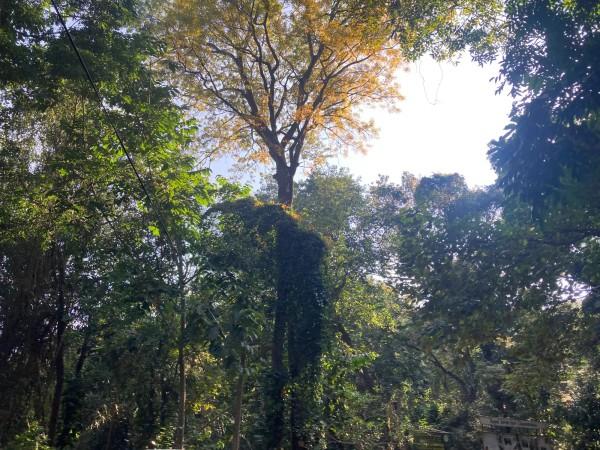
Udawattakele Forest Reserve - © gather
Essential Travel Information
Getting to Kandy
Airport Transfers
The nearest airport to Kandy is Bandaranaike International Airport in Colombo, located about 115 km away. Private taxis or transfers can be pre-booked for the 3-4 hour journey to Kandy. Some hotels also offer airport pickup services.
Train
One of the most scenic ways to travel to Kandy is by train from Colombo, taking about 3-4 hours. Trains depart from Colombo Fort Station and arrive at Kandy Station.
Bus
Both public and private buses run frequently between Colombo and Kandy, with travel times ranging from 3-4 hours depending on traffic conditions.
Getting Around Kandy
Public Transit
Local buses operate within Kandy, though routes may be confusing for visitors. Tuk-tuks (three-wheeled auto rickshaws) are a popular, affordable, and quick way to travel short distances.
Taxis
Metered taxis are available, and many hotels can arrange them for guests.
Ride-Hailing
Apps like PickMe and Uber operate in Kandy, offering convenient ride-hailing services.
Walking
Kandy’s city center, especially around Kandy Lake, is compact and easily walkable.
Renting
Motorbikes and bicycles can be rented from local shops and guesthouses for those looking to explore the area independently.
ATM and Banking Services in Kandy
ATM Availability
ATMs are widely available in Kandy, including a State Bank of India (SBI) ATM located at No. 15-1/1, Temple Street.
ATM Services
ATMs in Kandy typically offer services like cash withdrawals (up to LKR 100,000 per day), balance inquiries, PIN changes, and mini statements.
ATM Accessibility
Most ATMs are operational 24/7, though some located inside bank branches may follow the branch’s operating hours. ATMs in Kandy accept foreign debit and credit cards, making it easy for international travelers to access cash.
ATM Fees
Transaction fees range from Rs. 0 to Rs. 1,000 per transaction, depending on the bank and the type of card used. Some ATMs charge no fees.
Withdrawal Limits
The typical withdrawal limit per transaction is between Rs. 40,000 and Rs. 60,000, with some ATMs allowing up to Rs. 100,000.
Banking Hours
Banks in Kandy usually operate from 9:00 am to 3:00 pm on weekdays.
Currency Exchange
Authorized currency exchange services are readily available in major towns like Kandy.
Safety Tips for ATM Use
- Never share your PIN and change it as soon as possible after receiving it.
- Be cautious of any suspicious devices attached to ATMs.
- Avoid using ATMs in isolated or poorly lit areas.
- Register for SMS alerts to stay updated on your transactions.
Articles for you

Explore Yala National Park - Sri Lanka Travel, Asia
Tucked away in Sri Lanka’s southeastern corner, Yala National Park is where wild nature meets deep tradition. Known worldwide for its leopard population, the park is also home to elephants, sloth bears, crocodiles, and hundreds of bird species. Beyond wildlife, Yala opens doors to a cultural landscape dotted with ancient temples, Buddhist ruins, and coastal villages. For travelers seeking more than just a safari, Yala offers a chance to explore eco-tourism, local communities, and sacred heritage sites.
Population: The Yala National Park area doesn’t have a human population.
Economy: The economy around Yala National Park thrives on a blend of eco-tourism, agriculture, and local services. Safari tours, eco-lodges, and cultural experiences drive steady income for nearby towns like Tissamaharama and Kataragama, supporting thousands of families.
Landmarks: Famous for Block I of Yala and wildlife encounters, including elephants, sloth bears, crocodiles, and exotic bird species.

Explore Galle - Sri Lanka Travel, Asia
Nestled on Sri Lanka’s southern coastline, Galle is a vibrant city where history meets the sea. Its cobbled streets, colonial architecture, and serene beaches make it a must-visit destination for travelers seeking a blend of culture, adventure, and relaxation. A UNESCO World Heritage site, Galle captivates visitors with its Dutch Fort, bustling markets, and friendly locals. Whether you’re exploring the ramparts at sunset or savoring fresh seafood by the shore, Galle promises an unforgettable journey into Sri Lanka’s heritage.
Population: Approximately 113,000 in 2023.
Economy: Galle’s economy thrives on tourism, trade, and fisheries. The city’s historic fort, colonial architecture, and coastal charm draw thousands of international visitors each year, making tourism its main economic driver. Fishing remains vital for local livelihoods, supplying fresh seafood across the region.
Landmarks: Famous for the Galle Fort, Dutch Reformed Church & Maritime Museum, and Unawatuna Beach.

Explore Bentota - Sri Lanka Travel, Asia
Nestled along Sri Lanka’s southwestern coast, Bentota is a tropical paradise that blends golden beaches, vibrant culture, and thrilling adventures. Famous for its calm waters, luxury resorts, and scenic river estuary, Bentota has become a top destination for travelers seeking both relaxation and authentic experiences. From serene beach walks at sunrise to adrenaline-pumping water sports, this coastal town offers a perfect balance of leisure and exploration. With its proximity to Colombo and Galle, Bentota is easy to reach, making it an ideal stop for both short escapes and extended holidays.
Population: Approximately 37,000 in 2023.
Economy: Bentota’s economy thrives mainly on tourism, which drives local businesses such as hotels, restaurants, and wellness retreats. The town also benefits from fishing, coconut cultivation, and handicrafts like wood carving and batik textiles. Many residents rely on the growing demand for water sports and Ayurvedic treatments, making tourism the backbone of both income and employment in the area.
Landmarks: Famous for Bentota Beach, Bentota River Safari, and Kande Vihara Temple.

Explore Mirissa - Sri Lanka Travel, Asia
Mirissa is a charming coastal town on Sri Lanka’s southern shoreline. Known for its golden beaches, turquoise waters, and vibrant marine life, it has become a must-visit stop for travelers exploring the island. Many come for whale watching, surfing, and sunset views at Coconut Tree Hill, but Mirissa offers much more than postcard beauty. The fishing boats you see anchored by the bay carry generations of stories. Local traditions, delicious cuisine, and a laid-back rhythm of life shape every visitor’s experience.
Population: Approximately 4,700 in 2023.
Economy: Mirissa’s economy is largely shaped by its coastal location. Fishing has long been the backbone of local livelihoods, with generations relying on the Indian Ocean for income. In recent decades, tourism has become the main driver of growth, thanks to whale watching, surfing, and beachside hospitality.
Landmarks: Famous for Mirissa Beach, Coconut Tree Hill, and Parrot Rock Bridge.

Explore Nuwara Eliya - Sri Lanka Travel, Asia
Tucked away in the Central Highlands of Sri Lanka, Nuwara Eliya is often called “Little England”. With its rolling tea plantations, cool misty mornings, and colonial charm, this mountain town feels like a step into another world. Travelers come here to breathe fresh air, walk through flower gardens, sip the finest Ceylon Tea, and enjoy a pace of life far from the island’s busy cities. Whether you’re drawn by scenic landscapes, heritage architecture, or the warmth of its people, Nuwara Eliya is a destination that blends nature, culture, and history in perfect harmony.
Population: Approximately 781,000 in 2023.
Economy: Nuwara Eliya’s economy thrives mainly on tea production, as it sits in the heart of Sri Lanka’s central highlands, famous worldwide for Ceylon Tea. The city also benefits from a growing tourism industry, attracting visitors with its colonial charm, cool climate, and scenic landscapes.
Landmarks: Famous for Gregory Lake, Hakgala Botanical Garden, and Victoria Park.

Explore Sukau - Malaysia Travel, Asia
Nestled on the banks of the Kinabatangan River in Sabah, Malaysian Borneo, Sukau is a destination where wildlife, culture, and conservation come together. Known as one of Asia’s top spots for river safaris and eco-tourism, this quiet village offers a front-row seat to encounters with Bornean orangutans, pygmy elephants, proboscis monkeys, and exotic birdlife.
Population: Approximately 1,400 in 2019.
Economy: Sukau’s economy is shaped by its riverine location and natural resources. Traditionally, the Orang Sungai community relied on fishing, small-scale farming, and forest gathering for their livelihood. Today, the village has shifted toward eco-tourism, with river cruises, jungle trekking, and homestays providing income.
Landmarks: Famous for the Kinabatangan River cruises, Gomantong Caves, and Ox-bow lakes and wetlands.
